Spatiotemporal Evolution of Habitat Quality and Scenario Modeling Prediction in the Tuha Region
Abstract
1. Introduction
2. Materials and Methods
2.1. Study Area
2.2. Data and Preprocessing
2.3. Methods
2.3.1. InVEST Model
2.3.2. Spatial Autocorrelation Analysis
2.3.3. Human Footprint Index (HFI) Evaluation
2.3.4. Ecological Zoning
2.3.5. PLUS Model
- (1)
- Driver selection
- (2)
- Parameterization of domain weights
- (3)
- Accuracy verification
- (4)
- Multi-scenario settings
- (5)
- Matrix of transfer costs
3. Results
3.1. Spatial and Temporal Distribution of HQ
3.2. Spatial Autocorrelation Analysis of HQ and Habitat Degradation
3.3. Spatial and Temporal Distribution Characteristics of the HFI
3.4. Results of Ecological Zoning
3.5. Land Use Multi-Scenario Simulation Projections
3.6. Characterization of Changes in HQ under Different Scenarios
4. Discussion
4.1. Features of the Changing and Degrading HQ of the Tuha Region
4.2. Scenario Modeling and Model
5. Conclusions
- (1)
- From 2000 to 2020, the average habitat quality in Tuha area decreased from 0.15 to 0.14. In the past 20 years, the habitat quality in Tuha region was mainly low grade. The proportion of low grade increased from 83.63% to 84.24%. At the same time, the habitat quality of the medium and high grades was transferred to the low grades, accounting for 27.17% and 72.83% respectively. Spatially, high-grade habitat quality is primarily concentrated in the Tianshan Mountains, which is largely influenced by conservation policies and experiences less human disturbance. The low-grade habitat quality is mainly distributed in districts and counties, which is caused by urban development.
- (2)
- From 2000 to 2020, the global Moran’s index values for HQ were demonstrated to be above 0.95 and significant at the 0.001 level, and the habitat degradation index values were all above 0.75, passing the 95% confidence evaluation. This suggests that HQ and degradation are spatially clustered and dependent, conducive to ecological protection and ecological restoration.
- (3)
- From 2000 to 2020, the proportion of high HFI increased, whereas the proportion of low HFI decreased, falling from 96.20% to 91.22%. Spatially, high HFI is predominantly concentrated in districts, counties, as well as along highways and railways. Conversely, low HFI is mainly found in vast areas of unutilized land.
- (4)
- In the ND scenario, the proportion of high HQ is 10.10% in 2040. In the EP scenario, the proportion of high HQ is 10.30% in 2040. In the UD scenario, the proportion of high HQ is 10.06% in 2040. Compared to the ND and UD scenarios, the habitat degradation under the EP scenario is less severe, making it more conducive to the sustainable development of habitat quality in the Tuha area.
Author Contributions
Funding
Data Availability Statement
Conflicts of Interest
References
- Zhao, Y.; Qu, Z.; Zhang, Y.; Ao, Y.; Han, L.; Kang, S.; Sun, Y. Effects of human activity intensity on habitat quality based on nighttime light remote sensing: A case study of Northern Shaanxi, China. Sci. Total Environ. 2022, 851, 158037. [Google Scholar] [CrossRef] [PubMed]
- Zhang, G.; Roslan, S.N.A.; Quan, L.; Yuan, P. Simulation of spatiotemporal patterns of habitat quality and driving mechanism in Anhui province, China. Front. Environ. Sci. 2023, 11, 1145626. [Google Scholar] [CrossRef]
- Deng, Y.; Jiang, W.; Wang, W.; Lv, J.; Chen, K. Urban expansion led to the degradation of habitat quality in the Beijing-TianjinHebei Area. Acta Ecol. Sin. 2018, 38, 4516–4525. [Google Scholar]
- Song, S.; Liu, Z.; He, C.; Lu, W. Evaluating the effects of urban expansion on natural habitat quality by coupling localized shared socioeconomic pathways and the land use scenario dynamics-urban model. Ecol. Indic. 2020, 112, 106071. [Google Scholar] [CrossRef]
- Tang, J.; Zhou, L.; Dang, X.; Hu, F.; Yuan, B.; Yuan, Z.; Wei, L. Impacts and predictions of urban expansion on habitat quality in the densely populated areas: A case study of the Yellow River Basin, China. Ecol. Indic. 2023, 151, 110320. [Google Scholar] [CrossRef]
- Yuan, H.; Cai, J.; Zhang, L. Temporal and spatial changes of human activities and habitat quality in national key ecological function areas and their spatial effects. Arid. Land Geogr. 2023, 46, 934–948. [Google Scholar]
- Jiang, W.; Wu, J. Spatio-temporal evolution of habitat quality in Guangdong-Hong Kong-Macao Greater Bay Area based on regional GDP and population spatial distribution. Acta Ecol. Sin. 2021, 41, 1747–1757. [Google Scholar]
- Wang, P.; Qin, S.; Hu, H. Spatial-temporal evolution characteristics of land use change and habitat quality in the Lhasa River Basin over the past three decades. Arid. Zone Res. 2023, 40, 492–503. [Google Scholar] [CrossRef]
- Yue, W.; Xia, H.; Wu, T.; Xiong, J.; Hong, P.; Chen, Y. Spatio-temporal evolution of habitat quality and ecological red line assessment in Zhejiang Province. Acta Ecol. Sin. 2022, 42, 6406–6417. [Google Scholar]
- Lv, L.; Zhang, J.; Sun, C.; Wang, X.; Zheng, D. Landscapeecological risk assessment of Xi river Basin based on land-use change. Acta Ecol. Sin. 2018, 38, 5952–5960. [Google Scholar]
- Xie, Y.; Gong, J.; Zhang, S.; Ma, X.; Hu, B. Spatiotemporal Change of Landscape Biodiversity Based on InVEST Model and Remote Sensing Technology in the Bailong River Watershed. Sci. Geogr. Sin. 2018, 38, 979–986. [Google Scholar] [CrossRef]
- Tang, Y.; Zhu, W.; Zhang, H.; Song, Y. A review on principle and application of the InVEST model. Ecol. Sci. 2015, 34, 204–208. [Google Scholar] [CrossRef]
- Zhang, H.; Li, J.; Tian, P.; Wang, Z.; Shen, X. Spatio-temporal evolution of habitat quality in the East China Sea continental coastal zone based on land use changes. Acta Ecol. Sin. 2023, 43, 937–947. [Google Scholar]
- Sallustio, L.; De Toni, A.; Strollo, A.; Di Febbraro, M.; Gissi, E.; Casella, L.; Geneletti, D.; Munafò, M.; Vizzarri, M.; Marchetti, M. Assessing habitat quality in relation to the spatial distribution of protected areas in Italy. J. Environ. Manag. 2017, 201, 129–137. [Google Scholar] [CrossRef] [PubMed]
- Yohannes, H.; Soromessa, T.; Argaw, M.; Dewan, A. Spatio-temporal changes in habitat quality and linkage with landscape characteristics in the Beressa watershed, Blue Nile basin of Ethiopian highlands. J. Environ. Manag. 2021, 281, 111885. [Google Scholar] [CrossRef] [PubMed]
- Mengist, W.; Soromessa, T.; Feyisa, G.L. Landscape change effects on habitat quality in a forest biosphere reserve: Implications for the conservation of native habitats. J. Clean. Prod. 2021, 329, 129778. [Google Scholar] [CrossRef]
- Harris, J.P.; Smith, L.M.; McMurry, S.T. Interacting gradients of selection and survival probabilities to estimate habitat quality: An example using the Gray Vireo (Vireo vicinior). Ecol. Indic. 2021, 131, 108210. [Google Scholar] [CrossRef]
- Terrado, M.; Sabater, S.; Chaplin-Kramer, B.; Mandle, L.; Ziv, G.; Acuña, V. Model development for the assessment of terrestrial and aquatic habitat quality in conservation planning. Sci. Total Environ. 2016, 540, 63–70. [Google Scholar] [CrossRef]
- Gao, Z.; Wang, X.; Sui, X.; Wang, X.; Fan, Y.; Zhu, Q.; Lv, L. Multi-scenario prediction of habitat quality in Nanjing based on FLUS and InVEST models. J. Agric. Resour. Environ. 2022, 39, 1001–1013. [Google Scholar] [CrossRef]
- Zheng, J.; Xie, B.; You, X. Spatio-temporal characteristics of habitat quality based on land-use changes in Guangdong Province. Acta Ecol. Sin. 2022, 42, 6997–7010. [Google Scholar]
- Han, C.; Zheng, J.; Wang, Z.; Yu, W. Spatio-temporal variation and multi-scenario simulation of carbon storage in terrestrial ecosystems in TurpanHami Basin based on PLUS-InVEST model. Arid. Land Geogr. 2023, 1–15. [Google Scholar]
- Hu, F.; Zhang, Y.; Guo, Y.; Zhang, P.; Lv, S.; Zhang, C. Spatial and temporal changes in land use and habitat quality in the Weihe River Basin based on the PLUS and InVEST models and predictions. Arid. Land Geogr. 2022, 45, 1125–1136. [Google Scholar]
- Yang, L.; Wang, J.; Zhou, W. Coupling evolution analysis of LUCC and habitat quality in Dongting Lake Basin Based on multi-scenario simulation. China Environ. Sci. 2023, 43, 863–873. [Google Scholar] [CrossRef]
- Pan, Y.; Yin, Y.; Hou, W.; Han, H. Spatiotemporal variation of habitat quality in the Source Region of the Yellow River based on land use and vegetation cover changes. Acta Ecol. Sin. 2022, 42, 7978–7988. [Google Scholar]
- Teng, Y.; Xie, M.; Wang, H.; Chen, Y.; Li, F. Land use transition in resource-based cities and its impact on habitat quality: A case of Wuhai City. Acta Ecol. Sin. 2022, 42, 7941–7951. [Google Scholar]
- Berta Aneseyee, A.; Noszczyk, T.; Soromessa, T.; Elias, E. The InVEST Habitat Quality Model Associated with Land Use/Cover Changes: A Qualitative Case Study of the Winike Watershed in the Omo-Gibe Basin, Southwest Ethiopia. Remote Sens. 2020, 12, 1103. [Google Scholar] [CrossRef]
- Chen, H.; Zhao, Y.; Fu, X.; Wu, G. Characteristics of spatio-temporal evolution and influence mechanism of habitat quality in the upper reaches of the West Liaohe River. Acta Ecol. Sin. 2023, 43, 948–961. [Google Scholar]
- Wei, W.; Bao, Y.; Wang, Z.; Chen, X.; Sun, Y.; Zeng, M.; Mo, Y. Spatio-temporal responses of urban environment quality to land use change in mountainous cities of Karst areas. Acta Ecol. Sin. 2023, 43, 3920–3935. [Google Scholar]
- Dítě, Z.; Šuvada, R.; Tóth, T.; Jun, P.E.; Píš, V.; Dítě, D. Current Condition of Pannonic Salt Steppes at Their Distribution Limit: What Do Indicator Species Reveal about Habitat Quality? Plants 2021, 10, 530. [Google Scholar] [CrossRef]
- Mao, C.; Ren, Q.; He, C.; Qi, T. Assessing direct and indirect impacts of human activities on natural habitats in the Qinghai-Tibet Plateau from 2000 to 2020. Ecol. Indic. 2023, 157, 111217. [Google Scholar] [CrossRef]
- Wang, Q.; Yu, H.; Zhong, L.; Wang, H. Optimising the relationship between ecological protection and human development through functional zoning. Biol. Conserv. 2023, 281, 110001. [Google Scholar] [CrossRef]
- Yang, L.; Bian, C.; Pan, S.; Chen, W.; Zeng, J.; Xu, H.; Gu, T. Assessing the conservation effectiveness of theWorld’s protected areas: A habitat quality and human activities perspective. J. Clean. Prod. 2023, 431, 139772. [Google Scholar] [CrossRef]
- Qiu, Z.; Feng, Z.; Song, Y.; Li, M.; Zhang, P. Carbon sequestration potential of forest vegetation in China from 2003 to 2050: Predicting forest vegetation growth based on climate and the environment. J. Clean. Prod. 2020, 252, 119715. [Google Scholar] [CrossRef]
- Wu, Y.; Shi, K.; Chen, Z.; Liu, S.; Chang, Z. Developing improved time-series DMSP-OLS-like data (1992–2019) in China by integrating DMSP-OLS and SNPP-VIIRS. IEEE Trans. Geosci. Remote Sens. 2021, 60, 4407714. [Google Scholar] [CrossRef]
- Zhao, N.; Liu, Y.; Cao, G.; Samson, E.L.; Zhang, J. Forecasting China’s GDP at the pixel level using nighttime lights time series and population images. GIScience Remote Sens. 2017, 54, 407–425. [Google Scholar] [CrossRef]
- Wang, Z.; Huang, C.; Li, L.; Lin, Q. Ecological zoning planning and dynamic evaluation coupled with Invest-HFI-Plus model: A case study in Bortala Mongolian Autonomous Prefecture. Acta Ecol. Sin. 2022, 42, 5789–5798. [Google Scholar]
- Sanderson, E.W.; Jaiteh, M.; Levy, M.A.; Redford, K.H.; Wannebo, A.V.; Woolmer, G. The human footprint and the last of the wild: The human footprint is a global map of human influence on the land surface, which suggests that human beings are stewards of nature, whether we like it or not. BioScience 2002, 52, 891–904. [Google Scholar] [CrossRef]
- Zhang, X.; Ning, X.; Wang, H.; Liu, Y.; Liu, R. Impact of human footprint on landscape fragmentation in the Northeastern China Tiger and Leopard National Park. Acta Ecol. Sin. 2022, 42, 4688–4702. [Google Scholar]
- Duan, Q.; Luo, L. A dataset of human footprint over the Qinghai-Tibet Plateau during 1990–2015. Chin. Sci. Data 2020, 5, 303–312. [Google Scholar]
- Huang, Z.; Chen, Y.; Zheng, Z.; Wu, Z. Spatiotemporal coupling analysis between human footprint and ecosystem service value in the highly urbanized Pearl River Delta urban Agglomeration, China. Ecol. Indic. 2023, 148, 110033. [Google Scholar] [CrossRef]
- Venter, O.; Sanderson, E.W.; Magrach, A.; Allan, J.R.; Beher, J.; Jones, K.R.; Possingham, H.P.; Laurance, W.F.; Wood, P.; Fekete, B.M.; et al. Sixteen years of change in the global terrestrial human footprint and implications for biodiversity conservation. Nat. Commun. 2016, 7, 12558. [Google Scholar] [CrossRef] [PubMed]
- Chen, X.; Li, F.; Li, X.; Hu, Y.; Han, J.; Hu, P. Method and control measures of ecological space zoning in Pearl River Delta urban agglomeration. Acta Ecol. Sin. 2021, 41, 5233–5241. [Google Scholar]
- Wei, Q.; Abudureheman, M.; Halike, A.; Yao, K.; Yao, L.; Tang, H.; Tuheti, B. Temporal and spatial variation analysis of habitat quality on the PLUS-InVEST model for Ebinur Lake Basin, China. Ecol. Indic. 2022, 145, 109632. [Google Scholar] [CrossRef]
- Yuan, Z.; Wang, Q.; Wang, Y.; Li, W.; Gao, J.; Cheng, X.; Zhu, D. Impacts of land use change on ecosystem health in Chongqing under multi-scenario simulation. Acta Ecol. Sin. 2023, 43, 8279–8291. [Google Scholar] [CrossRef]
- Wang, S.; Peng, L. Land use multi-scenario simulation for balancing ecological protection and economic development. Acta Ecol. Sin. 2023, 43, 9938–9951. [Google Scholar] [CrossRef]
- Zhang, X.; Zhang, X.; Li, D.; Lu, L.; Yu, H. Multi-Scenario Simulation of the Impact of Urban Land Use Change on Ecosystem Service Value in Shenzhen. Acta Ecol. Sin. 2022, 42, 2086–2097. [Google Scholar]
- Admasu, S.; Yeshitela, K.; Argaw, M.; Bloor, M. Assessing habitat quality using the InVEST model in the Dire and Legedadi watersheds, central highland of Ethiopia: Implication for watershed management. Sustain. Environ. 2023, 9, 2242137. [Google Scholar] [CrossRef]
- Pu, J.; Shen, A.; Liu, C.; Wen, B. Impacts of ecological land fragmentation on habitat quality in the Taihu Lake basin in Jiangsu Province, China. Ecol. Indic. 2024, 158, 111611. [Google Scholar] [CrossRef]
- Wang, W.; Yang, J.; Yang, G. Coordination characteristics and influencing mechanisms of habitat quality, ecological sensitivity and net primary production: A case study on Yangtze river economic belt in China. Environ. Dev. 2024, 49, 100969. [Google Scholar] [CrossRef]
- Zhou, J.; Cai, M.; Huang, Z.; Guo, F.; Zhai, J. Spatio-temporal evolution characteristics and prediction of habitat quality in Jiangxi Province. Acta Ecol. Sin. 2023, 43, 7623–7636. [Google Scholar] [CrossRef]
- Raji, S.A.; Odunuga, S.; Fasona, M. Spatially Explicit Scenario Analysis of Habitat Quality in a Tropical Semi-arid Zone: Case Study of the Sokoto–Rima Basin. J. Geovis. Spat. Anal. 2022, 6, 1–21. [Google Scholar] [CrossRef]
- Chen, Y.; He, Z.; Yue, T.; Mu, W.; Qin, F. Spatiotemporal evolution and multi-scenario prediction of habitat quality in the Yellow River Basin. Front. Ecol. Evol. 2023, 11, 1226676. [Google Scholar] [CrossRef]
- Li, X.; Liu, Z.; Li, S.; Li, Y. Multi-Scenario Simulation Analysis of Land Use Impacts on Habitat Quality in Tianjin Based on the PLUS Model Coupled with the InVEST Model. Sustainability 2022, 14, 6923. [Google Scholar] [CrossRef]
- Mutale, B.; Qiang, F. Modeling future land use and land cover under different scenarios using patch-generating land use simulation model. A case study of Ndola district. Front. Environ. Sci. 2024, 12, 1362666. [Google Scholar] [CrossRef]
- Zhang, T.; Chen, Y. The effects of landscape change on habitat quality in arid desert areas based on future scenarios: Tarim River Basin as a case study. Front. Plant Sci. 2022, 13, 1031859. [Google Scholar] [CrossRef]
- Wang, Y.; Wang, B.; Wu, X. Impact of land use compactness change on the habitat quality of green space in Wuhan City. Acta Ecol. Sin. 2023, 43, 5726–5739. [Google Scholar]
- Yang, L.; Chen, W.; Zeng, J.; Wang, G.; Yuan, J. Gradient differences of the impact of urbanization on habitat quality in the Yangtze River Basin. Acta Ecol. Sin. 2024, 10, 1–13. [Google Scholar] [CrossRef]
- Qi, Y.; Hu, Y. Spatiotemporal Variation and Driving Factors Analysis of Habitat Quality: A Case Study in Harbin, China. Land 2024, 13, 67. [Google Scholar] [CrossRef]
- Cao, C.; Luo, Y.; Xu, L.; Xi, Y.; Zhou, Y. Construction of ecological security pattern based on InVEST-Conefor-MCRM: A case study of Xinjiang, China. Ecol. Indic. 2024, 159, 111647. [Google Scholar] [CrossRef]
- Louis, V.; Page, S.E.; Tansey, K.J.; Jones, L.; Bika, K.; Balzter, H. Tiger Habitat Quality Modelling in Malaysia with Sentinel-2 and InVEST. Remote Sens. 2024, 16, 284. [Google Scholar] [CrossRef]
- Wu, L.; Luo, Y.; Pang, S.; Wang, G.; Ma, X. Factor analysis of hydrologic services in water-controlled grassland ecosystems by InVEST model and geodetector. Environ. Sci. Pollut. Res. 2024, 31, 20409–20433. [Google Scholar] [CrossRef] [PubMed]
- Zheng, Y.; Liu, Q.; Huang, X.; Liu, F.; Yao, J.; Qin, G.; Zeng, H.; Yan, Y. Community structure of fish in mangrove forests of the Leizhou Peninsula and its relationship with human activity intensity. Acta Ecol. Sin. 2024, 44, 440–453. [Google Scholar] [CrossRef]
- Chen, H.; Liu, L.; Zhang, Z.; Liu, Y.; Tian, H.; Kang, Z.; Wang, T.; Xueying, Z. Spatiotemporal correlation between human activity intensity and surface temperature on the north slope of Tianshan Mountains. Acta Geogr. Sin. 2022, 77, 1244–1259. [Google Scholar]
- Li, Y.; Yu, B.; Wu, Z.; Li, S.; Wang, J. A method of wilderness assessment in Chinese land based on human activity perspective. Acta Ecol. Sin. 2024, 49. [Google Scholar] [CrossRef]
- Moreira, M.; Fonseca, C.; Vergílio, M.; Calado, H.; Gil, A. Spatial assessment of habitat conservation status in a Macaronesian island based on the InVEST model: A case study of Pico Island (Azores, Portugal). Land Use Policy 2018, 78, 637–649. [Google Scholar] [CrossRef]



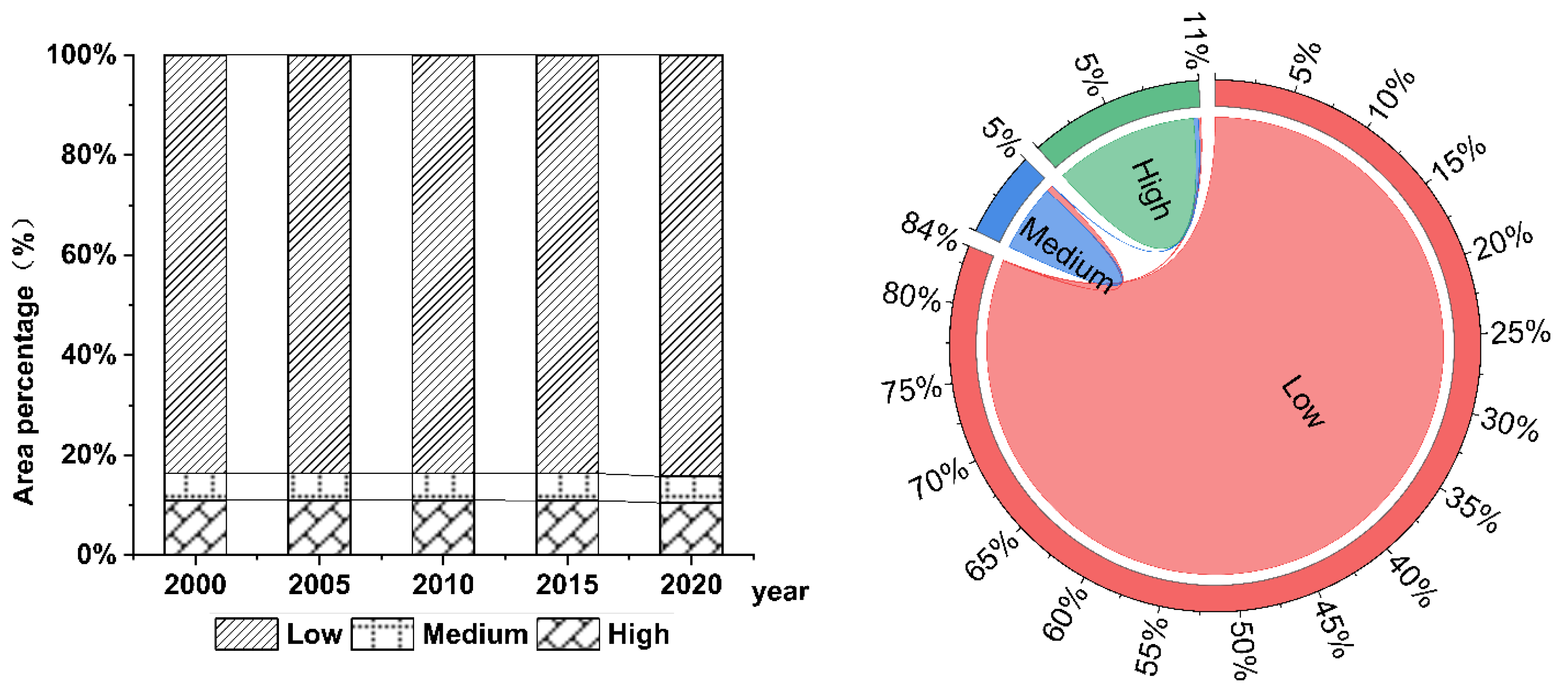
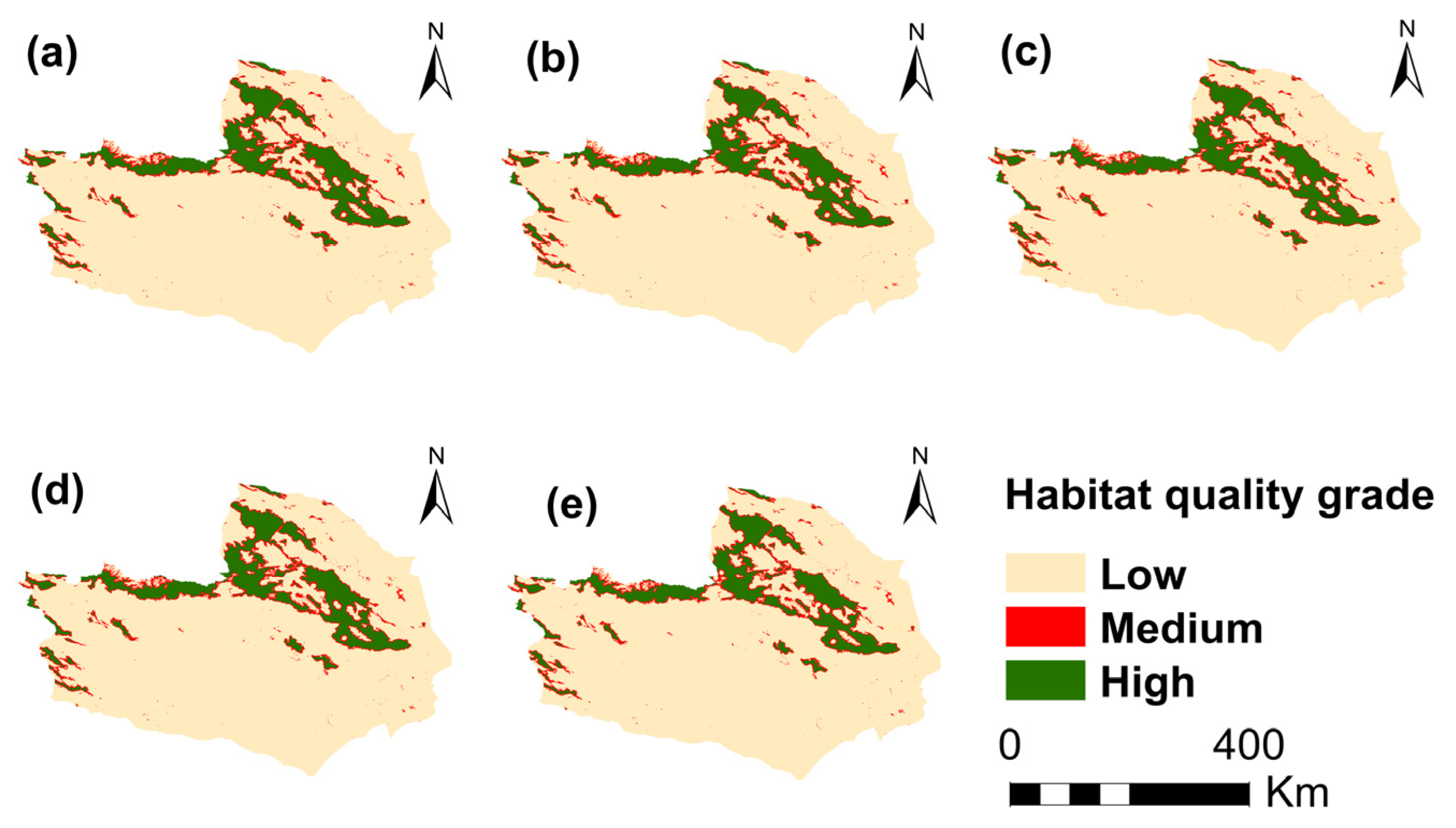

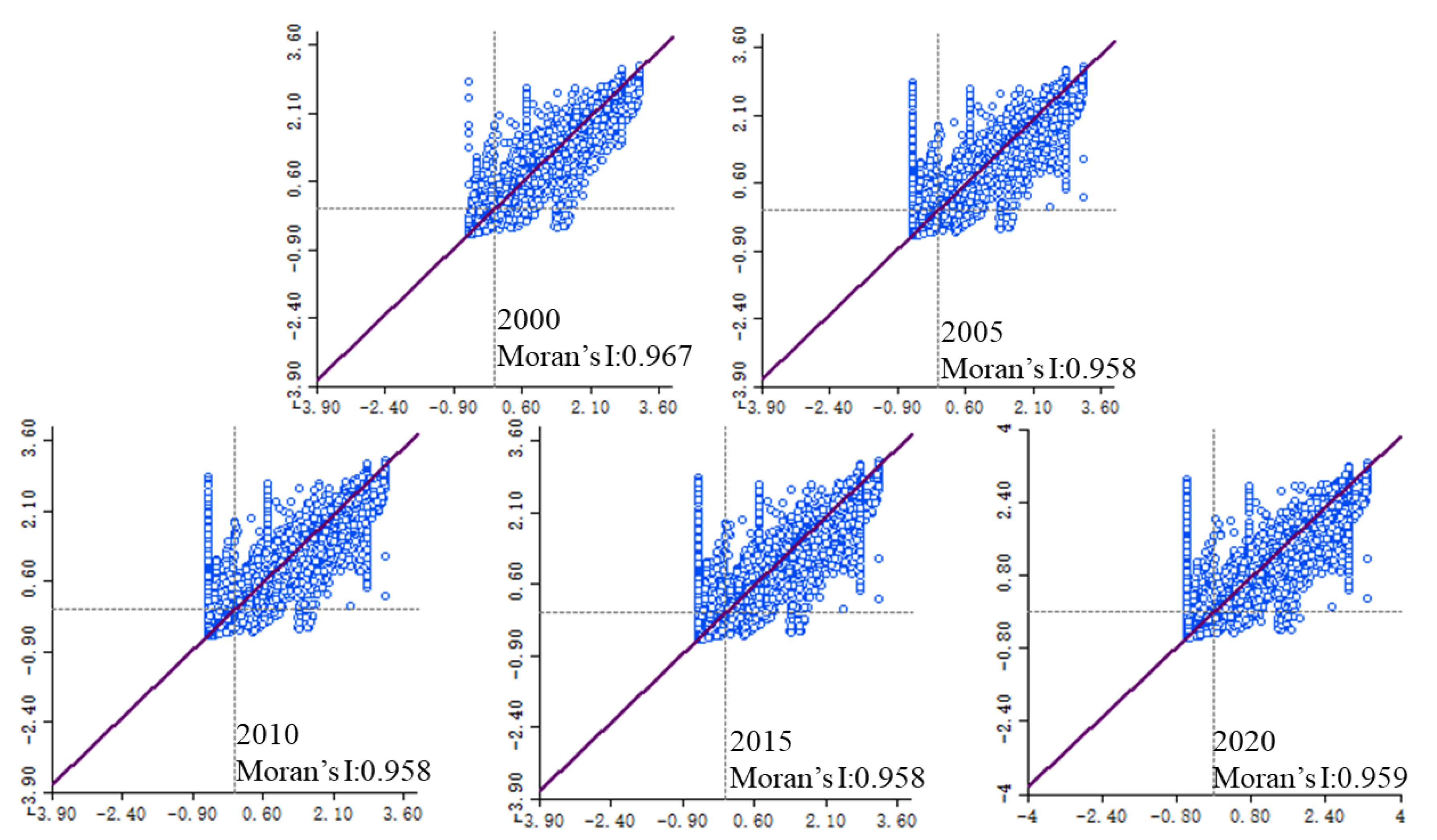
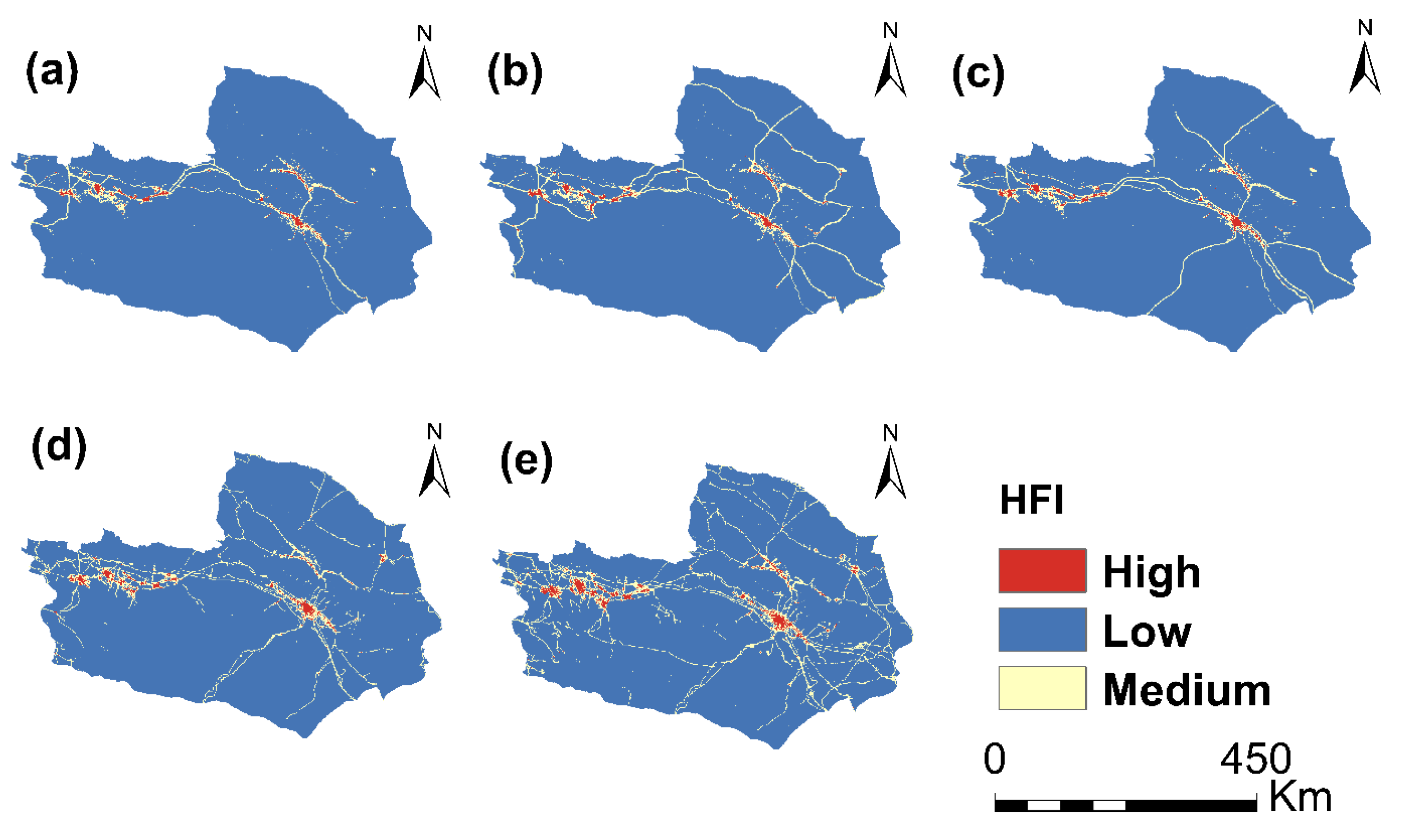
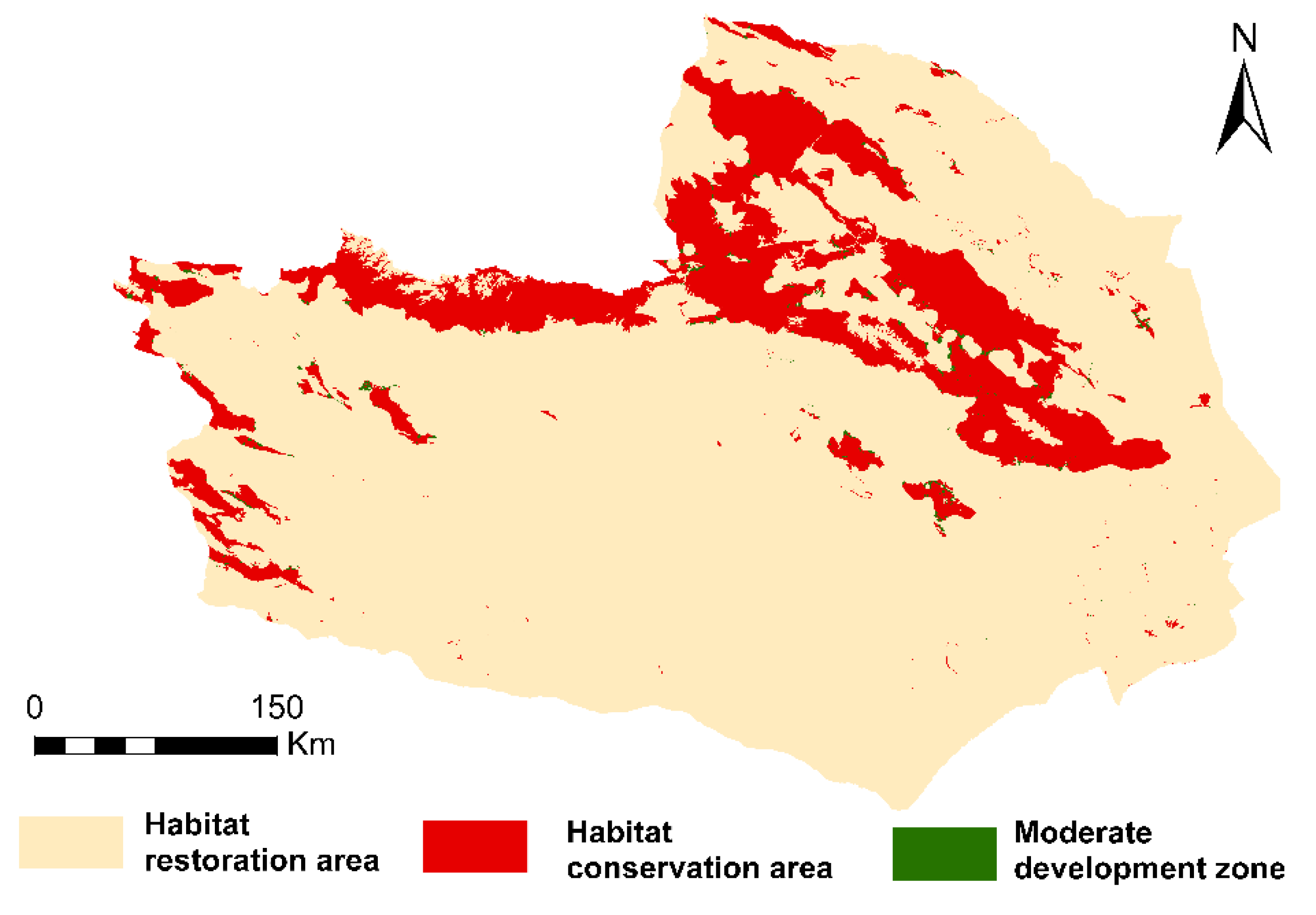

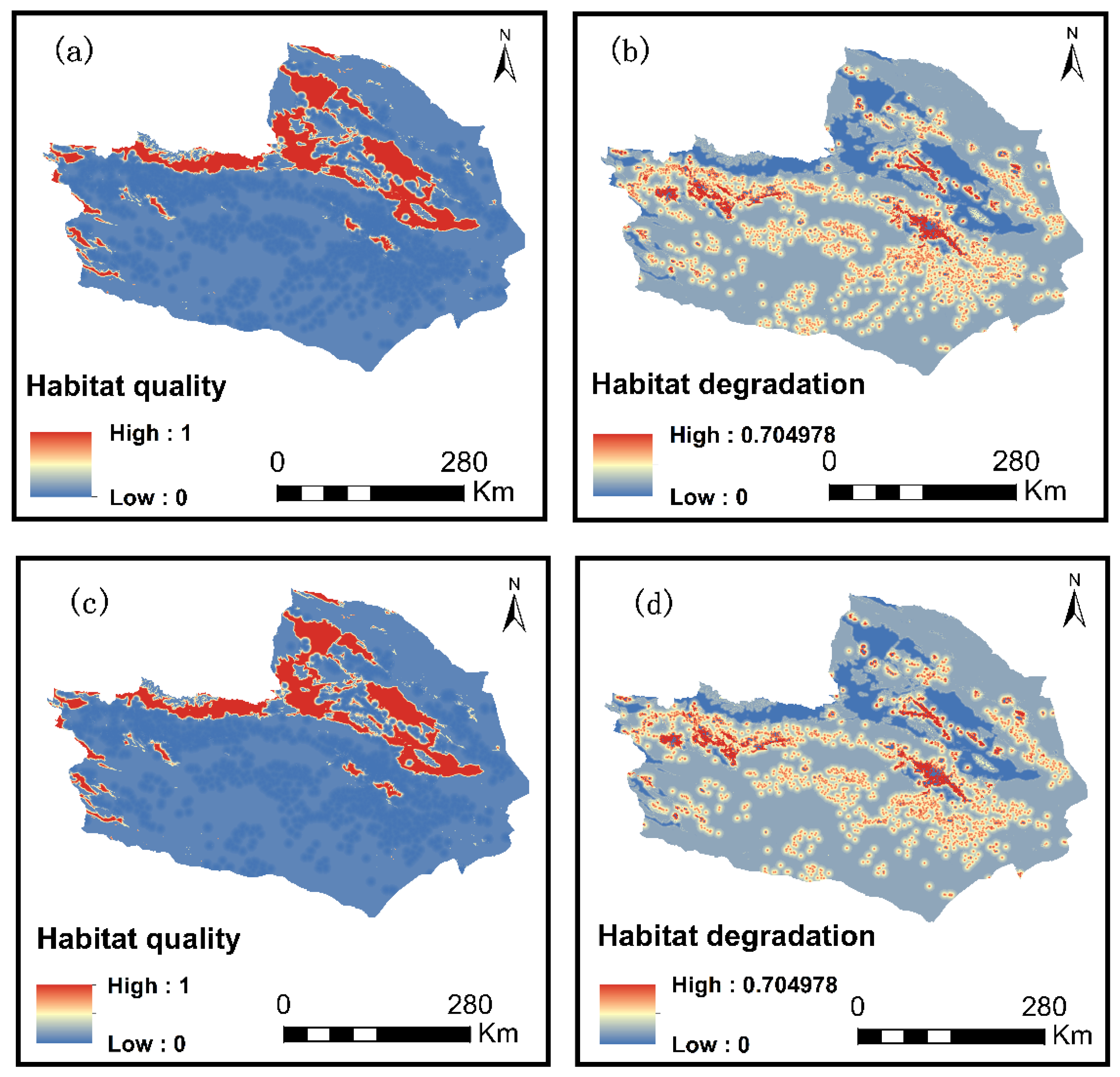
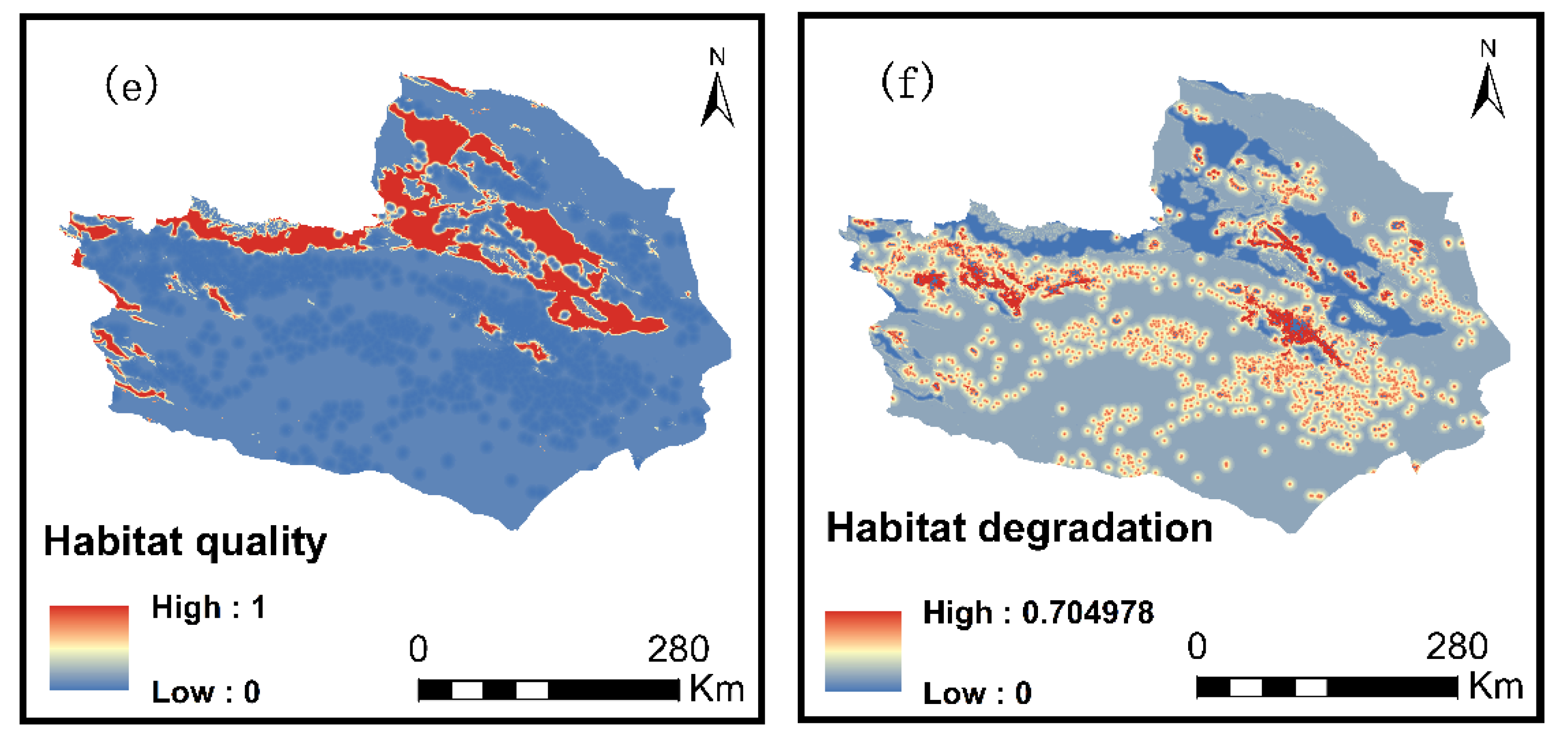
| Data Name | Spatial Resolution | Type | Time Range | Source |
|---|---|---|---|---|
| LULC | 30 m | tif | 2000, 2005, 2010, 2015, 2020 | The Resource and Environment Science and Data Center (https://www.resdc.cn accessed on 10 November 2023) |
| DEM | 30 m | tif | 2019 | Geospatial Data Cloud (https://www.gscloud.cn/search accessed on 12 November 2023) |
| Temperatures | 1 km | tif | 2019 | National Tibetan Plateau Science Data Center (https://data.tpdc.ac.cn/home accessed on 15 November 2023) |
| Precipitation | 1 km | tif | 2019 | |
| Roads, railroads | 1 km | shp | 2000–2010 2015–2020 | Artificial digitization open street map |
| Night lights | 1 km | tif | 2000, 2005, 2010, 2015, 2020 | Paper [34] |
| Population density | 1 km | tif | 2000, 2005, 2010, 2015, 2020 | LandScan |
| GDP | 1 km | tif | 2019 | Paper [35] |
| Soil type | 1:4,000,000 | shp | 2000 | 1:4 million soil map of China |
| Threat Factor | Maximum Impact Distance (km) | Weight | Attenuation Type |
|---|---|---|---|
| Crop land | 2 | 0.2 | Linear |
| Urbanized land | 8 | 1 | Exponential |
| Unused land | 3 | 0.4 | Linear |
| LULC Type | Habitat Suitability | Threats Factors | ||
|---|---|---|---|---|
| Crop Land | Urbanized Land | Unused Land | ||
| Crop land | 0.4 | 0.2 | 0.9 | 0.5 |
| Forest land | 1 | 0.5 | 0.8 | 0.2 |
| Grass land | 0.9 | 0.2 | 0.5 | 0.3 |
| Water body | 1 | 0.4 | 0.6 | 0.5 |
| Urbanized land | 0 | 0 | 0 | 0 |
| Unused land | 0.1 | 0.1 | 0.3 | 0.2 |
| Scene Mode | Principles and Restricted Development Zones |
|---|---|
| Natural development | In the natural development scenario, based on the expansion of land use types from 2000 to 2020, no parameters are adjusted. |
| Ecological preservation | Under the EP scenario, the results of ecological zoning designated the habitat conservation area as limited regions. The probability of converting cropland into forestland and grassland was stipulated to increase by 20% by combining the Markov transfer matrix and referencing the research of Wang [45] and other scholars. The likelihood of converting cropland to urbanized land decreased by 30%. Additionally, the probability of forestland and grassland being converted to cropland decreased by 20%, whereas the probability of forestland and grassland being converted to urbanized land decreased by 50%. Finally, the likelihood of converting urbanized land into grassland and forestland increased by 50%. |
| Urban development | In the UD scenario, center city was designated as limited area and the possibility of unused land converting into other types of land was reduced by 30%. The possibility of crop land, forest and grassland converting into urbanized land was increased by 20%. |
| 2020–2040 | ND | EP | UD | |||||||||||||||
|---|---|---|---|---|---|---|---|---|---|---|---|---|---|---|---|---|---|---|
| a | b | c | d | e | f | a | b | c | d | e | f | a | b | c | d | e | f | |
| a | 1 | 1 | 1 | 1 | 1 | 1 | 1 | 0 | 0 | 0 | 0 | 0 | 1 | 0 | 0 | 0 | 1 | 1 |
| b | 1 | 1 | 1 | 1 | 1 | 1 | 0 | 1 | 0 | 0 | 0 | 0 | 1 | 1 | 1 | 0 | 1 | 1 |
| c | 1 | 1 | 1 | 1 | 1 | 1 | 1 | 0 | 1 | 0 | 1 | 0 | 1 | 1 | 1 | 1 | 1 | 1 |
| d | 0 | 0 | 0 | 1 | 0 | 0 | 0 | 1 | 1 | 1 | 0 | 0 | 0 | 0 | 0 | 1 | 1 | 0 |
| e | 0 | 0 | 0 | 0 | 1 | 0 | 0 | 0 | 0 | 0 | 1 | 0 | 0 | 0 | 0 | 0 | 1 | 0 |
| f | 1 | 1 | 1 | 1 | 1 | 1 | 1 | 1 | 1 | 1 | 1 | 1 | 1 | 1 | 1 | 1 | 1 | 1 |
| 2000 (km2) | 2020 (km2) | ||
|---|---|---|---|
| Low | Medium | High | |
| Low | 172,950.90 | 141.91 | 6.85 |
| Medium | 1027.84 | 10,096.50 | 56.04 |
| High | 383.52 | 735.68 | 21,575.89 |
| Human Footprint Index Scale | 2000 | 2005 | 2010 | 2015 | 2020 |
|---|---|---|---|---|---|
| Low | 96.20 | 94.90 | 95.10 | 94.04 | 91.22 |
| Medium | 3.13 | 4.35 | 4.11 | 5.09 | 7.46 |
| High | 0.66 | 0.75 | 0.79 | 0.87 | 1.32 |
| LULC | ND | EP | UD | |||
|---|---|---|---|---|---|---|
| Area/km2 | Ratio/% | Area/km2 | Ratio/% | Area/km2 | Ratio/% | |
| Cropland | 3384 | 1.64% | 3318 | 1.60% | 3376 | 1.63% |
| Forestland | 569 | 0.27% | 570 | 0.28% | 569 | 0.27% |
| Grassland | 38,250 | 18.48% | 38,392 | 18.55% | 38,233 | 18.48% |
| Waterbody | 326 | 0.16% | 326 | 0.16% | 321 | 0.16% |
| Urbanized land | 1423 | 0.69% | 1357 | 0.66% | 1466 | 0.71% |
| Unused land | 162,981 | 78.76% | 162,979 | 78.76% | 16,2978 | 78.76% |
| Habitat Quality Rating | ND | EP | UD | |||
|---|---|---|---|---|---|---|
| Region/km2 | Ratio/% | Region/km2 | Ratio/% | Region/km2 | Ratio/% | |
| Low | 175,426 | 84.77% | 174,888 | 84.51% | 175,369 | 84.74% |
| Medium | 10,619 | 5.13% | 10,744 | 5.19% | 10,746 | 5.19% |
| High | 20,897 | 10.10% | 21,310 | 10.30% | 20,827 | 10.06% |
Disclaimer/Publisher’s Note: The statements, opinions and data contained in all publications are solely those of the individual author(s) and contributor(s) and not of MDPI and/or the editor(s). MDPI and/or the editor(s) disclaim responsibility for any injury to people or property resulting from any ideas, methods, instructions or products referred to in the content. |
© 2024 by the authors. Licensee MDPI, Basel, Switzerland. This article is an open access article distributed under the terms and conditions of the Creative Commons Attribution (CC BY) license (https://creativecommons.org/licenses/by/4.0/).
Share and Cite
Wang, J.; Abulizi, A.; Mamitimin, Y.; Mamat, K.; Yuan, L.; Bai, S.; Yu, T.; Akbar, A.; Zhang, X.; Shen, F. Spatiotemporal Evolution of Habitat Quality and Scenario Modeling Prediction in the Tuha Region. Land 2024, 13, 1005. https://doi.org/10.3390/land13071005
Wang J, Abulizi A, Mamitimin Y, Mamat K, Yuan L, Bai S, Yu T, Akbar A, Zhang X, Shen F. Spatiotemporal Evolution of Habitat Quality and Scenario Modeling Prediction in the Tuha Region. Land. 2024; 13(7):1005. https://doi.org/10.3390/land13071005
Chicago/Turabian StyleWang, Junxia, Abudukeyimu Abulizi, Yusuyunjiang Mamitimin, Kerim Mamat, Le Yuan, Shaojie Bai, Tingting Yu, Adila Akbar, Xiaofen Zhang, and Fang Shen. 2024. "Spatiotemporal Evolution of Habitat Quality and Scenario Modeling Prediction in the Tuha Region" Land 13, no. 7: 1005. https://doi.org/10.3390/land13071005
APA StyleWang, J., Abulizi, A., Mamitimin, Y., Mamat, K., Yuan, L., Bai, S., Yu, T., Akbar, A., Zhang, X., & Shen, F. (2024). Spatiotemporal Evolution of Habitat Quality and Scenario Modeling Prediction in the Tuha Region. Land, 13(7), 1005. https://doi.org/10.3390/land13071005






